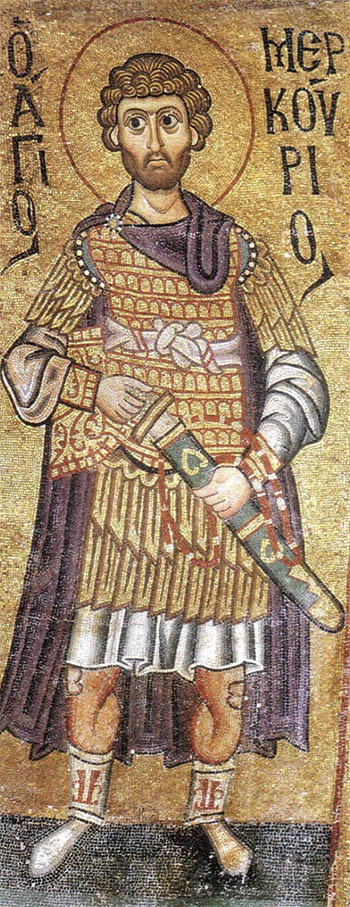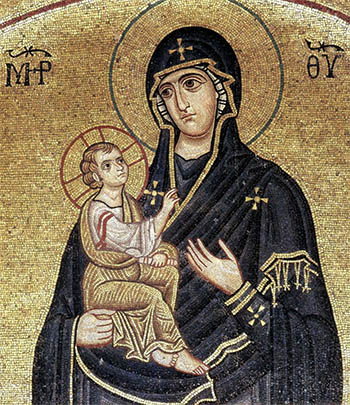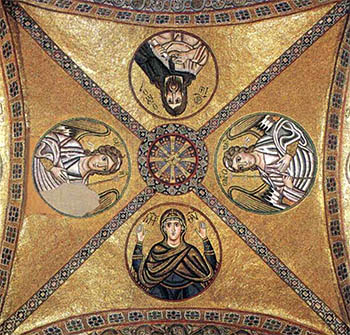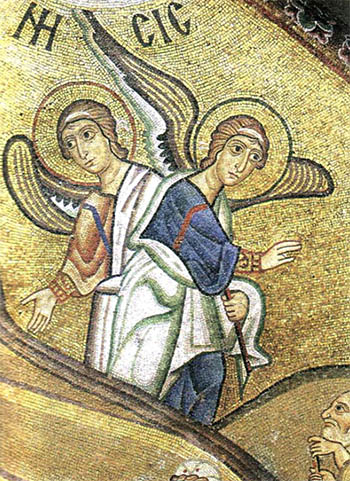










Christ Pantokrators of Hosios Loukas


There are two churches. Hosios Loukas "the Blessed Luke", dedicated to the saint of the same name and also called the Panagia, is the oldest and only church known with certainty to have been built in the tenth century in mainland Greece. Blessed Luke was a miracle-working saint. He died in 953 when he was 56. Luke also had the gift of prophecy - he predicted the successful reconquest of Crete 20 years before it occurred by Nikephoros Phocas during the reign of Romanos II in 961. During his lifetime Luke was supported by members of the military aristocracy in Thebes. When he died he was buried under the floor of his cell. Within a few years the first Oratory in the form of a cruciform chapel was built above his grave. Blessed Luke can be seen below:
 The first centralized church, a splendid building of generous proportions. is the oldest example of the cross-in-square type in Greece; its plan and style of architecture closely follows that of Lips Monastery in Constantinople. Taking advantage of local supplies of stone from Delphi, the walls are built of brick, stone, and marble) and display curious pseudo-arabic patterns. The style is called "cloisonne" and it became extremely popular throughout Greece. A fragment of a fresco of Joshua and the angel, believed to date from the reign of Nikephoros II Phocas - around 969 - was discovered in the church. It is thought that the fresco was originally in a chapel of the Archangel Michael which had a cycle of paintings dedicated to his miracles. The fresco is one of the first indicators of the military patronage and focus of both churches.
The first centralized church, a splendid building of generous proportions. is the oldest example of the cross-in-square type in Greece; its plan and style of architecture closely follows that of Lips Monastery in Constantinople. Taking advantage of local supplies of stone from Delphi, the walls are built of brick, stone, and marble) and display curious pseudo-arabic patterns. The style is called "cloisonne" and it became extremely popular throughout Greece. A fragment of a fresco of Joshua and the angel, believed to date from the reign of Nikephoros II Phocas - around 969 - was discovered in the church. It is thought that the fresco was originally in a chapel of the Archangel Michael which had a cycle of paintings dedicated to his miracles. The fresco is one of the first indicators of the military patronage and focus of both churches.
 Next to the Church of Hosios Loukas stands a larger church, or Katholikon, a large building dated to 1012 and built during the reign of Basil II, who had consolidated Byzantine power and authority in the Balkans through force of arms and terrorizing his enemies into submission. The building was carried out on the initiative of Abbot Philotheos.
Next to the Church of Hosios Loukas stands a larger church, or Katholikon, a large building dated to 1012 and built during the reign of Basil II, who had consolidated Byzantine power and authority in the Balkans through force of arms and terrorizing his enemies into submission. The building was carried out on the initiative of Abbot Philotheos.
The Katholikon is lavishly embellished with marble columns, piers, beams and revetment made from ancient sources near the site. It has large windows and the amount of light they provide in the church brightly illuminates the mosaics and marble with beams of light that move throughout the sanctuary during the day. The windows were set with clear and colored glass disks set in plaster frames.
The Katholikon is the earliest domed-octagon Byzantine church that survives, with eight marble-clad piers arranged around the perimeter of the naos. It was a thank offering for Basil's final victory over the Bulgarians - finally achieved in 1018. In the same year he Basil visited the Parthenon, which had been converted into a church and was now "Our Lady of Athens" to offer thanks to the Theotokos for his victories. Basil died in 1025 the same year the the new church was completed and decorated.
The hemispherical dome (without a drum) rests upon four squinches which make a transition from the octagonal base under the dome to the square defined by the walls below. The original dome collapsed sometime before 1593, when it was replaced with a new one decorated with frescoes rather than mosaics. The main cube of the church is surrounded by galleries and chapels on all four sides. One can be certain that the architects and builders came from Constantinople. Manual labor could have been provided by prisoners taken in Basil's battles. Basil operated an efficient military supply system through the empire. Enormous numbers of pack animals would have been required to transport heavy glass mosaic cubes from the nearest port to the building site. He had teams of military engineers who rapidly put up fortifications and cities. These military men were not artists who would understand style and beauty in architecture or mosaics. Their top concerns were getting the job done on time and on budget.
Basil II would have approved the plans for the church and the layout of mosaics and their saints. There was probably a book that was used onsite as a guide.
 Robin Cormack believes the mosaics of Daphni, Torcello and Hosios Loukas were created by the same workshop which moved from one project to another over several decades and generations of workers.
Robin Cormack believes the mosaics of Daphni, Torcello and Hosios Loukas were created by the same workshop which moved from one project to another over several decades and generations of workers.
This Pantokrator, just like the Pantokrator in the dome at Daphni, has a limited number of flesh tones. The larger the figure the more difficult it is to model it. The artist who created it had to use alternating lines of white and gray to make subtle shadows thus making a striped surface. Color in the cheeks was made the same way. They don't seem to have had many rosey-colored stone or red glass cubes. Sometimes Byzantine artists had to use pink-painted cubes.
The monochromatic color range of this icon makes the pale face feel flat and lacking life. The eyes are round and staring with sharply arched eyebrows. The ears are not strongly modeled and look like white blobs of flesh. There are no pink or red cubes in the ears used like one would normally find in an icon of the Pantokrator. The halo is extremely simple without jewels or even double lines. Simplicity extends to the gospel book that also is devoid of jewels and is focused completely on the well-drawn words of the page.
The shortage of shades of colors also extended to the modelling of clothes, especially white garments.
All of the mosaics are lid out in an orderly manner, rather like soldiers arrayed for battle. The most important thing about these mosaics is who they depict, not how beautiful they might be.







 click here for icons of christ
click here for icons of christ click here for icons of the theotokos
click here for icons of the theotokos click here for icons of angels
click here for icons of angels click here for icons of saints
click here for icons of saints








